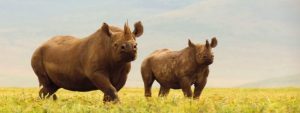
The Ngorongoro Crater is truly remarkable. Looking down into the immense bowl of the crater is like being in the Garden of Eden. The amazing colours, abundance of wildlife and huge variety of flora makes the crater a natural wonder. One of the best places to spot the ‘Big Five’ and the rare black rhino. We give you 9 reasons to visit the Ngorongoro Crater.
-
Big Five
Nearly all the big animals can be seen in the crater, including the Big Five (rhino, lion, leopard, buffalo, elephant).
-
Abundance of predators
The high numbers of herbivores supports the densest populations of predators found anywhere in Africa. Predators like lions, leopards, cheetah and hyenas can be seen hunting nearby on the open plains.
-
Africa’s Garden of Eden
The crater is also known as the ‘Garden of Eden’, cause of its stunning green grasses, blue water and the diversity of animals in the ‘small’ space of the crater. The ever-changing clouds, colours and landscapes make this crater magical.
-
Breathtaking views
Standing on the crest of the crater, you can see 610 metres (1900ft) below the giant crater floor. The beautiful pastel colours of the landscape, together with the ever dancing clouds and movement of wildlife, makes the view amazing - almost surreal.
-
World’s largest caldera
Ngorongoro crater is the largest intact caldera in the world - 610 metres (2 000 feet) deep and covers 260 square kilometers (100 square miles).
-
High game concentration
The crater shelters close to 30.000 animals (permanent) and in the peak season around 500.000. Its home to the highest density of wildlife in Africa.
-
Black rhino
In the crater you can spot the highly endangered black rhino (16 in total).
-
Unesco World Heritage Site
The crater is a protected area. It has global importance for biodiversity conservation due to the presence of globally threatened species, the density of wildlife inhabiting the area, and the annual migration of wildebeest, zebra, gazelles and other animals into the northern plains.
-
Variety of flora
There is the Lerai Forest, which is mainly comprised of yellow fever trees. To the north is a shallow soda lake called Lake Magadi with open grasslands and to the east you will find Gorigor Swamp and the Ngoitokitok Springs where pods of hippos are to be found.
The Ngorongoro Crater can be incorporated into you safari. Contact us for advice.

